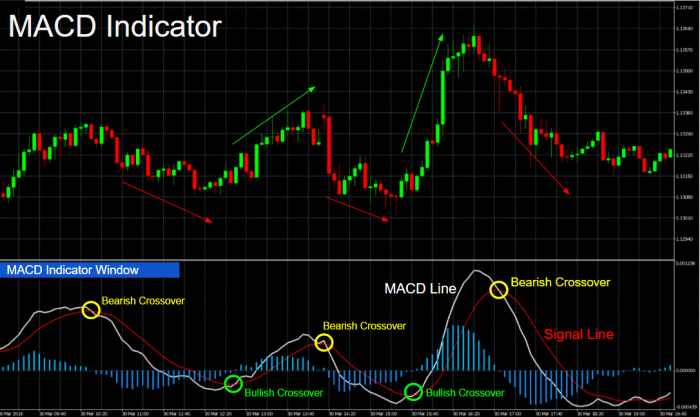The MACD forex strategy is a powerful tool that can help traders identify trends, momentum, and potential trading opportunities. By understanding the components of MACD (Moving Average Convergence Divergence) and how they interact, traders can gain a significant edge in the forex market.
This comprehensive guide will delve into the intricacies of the MACD forex strategy, providing you with everything you need to know to implement it successfully.
We’ll cover different types of MACD strategies, trading signals and indicators, risk management techniques, and advanced techniques to enhance your trading performance.
The MACD forex strategy is a trend-following strategy that uses the MACD (Moving Average Convergence Divergence) indicator to identify trading opportunities.

The MACD indicator is a momentum indicator that measures the difference between two exponential moving averages (EMAs) of a security’s price.
When the MACD line crosses above the signal line, it indicates that the security is in a bullish trend. Conversely, when the MACD line crosses below the signal line, it indicates that the security is in a bearish trend.
The Bollinger Bands strategy is another trend-following strategy that uses Bollinger Bands to identify trading opportunities.
Bollinger Bands are a volatility indicator that measures the distance between a security’s price and its moving average. When the Bollinger Bands are wide, it indicates that the security is volatile.
Conversely, when the Bollinger Bands are narrow, it indicates that the security is less volatile.
Introduction
The MACD (Moving Average Convergence Divergence) forex strategy is a powerful technical analysis tool used by traders to identify trends, momentum, and potential trading opportunities in the foreign exchange market. It is a versatile strategy that can be adapted to various trading styles and market conditions.
Components of MACD
The MACD indicator consists of three main components:
- MACD Line: The difference between the 12-period exponential moving average (EMA) and the 26-period EMA.
- Signal Line: A 9-period EMA of the MACD line.
- Histogram: The difference between the MACD line and the signal line.
These components are plotted together on a chart, providing traders with a visual representation of the relationship between the two moving averages and the momentum of the market.
Types of MACD Forex Strategies
There are several different types of MACD forex strategies, each with its own advantages and disadvantages:
- Trend-Following Strategies: These strategies use the MACD to identify and trade with the prevailing trend. Traders look for crossovers of the MACD line above or below the signal line to indicate a change in trend.
- Momentum Trading Strategies: These strategies focus on identifying and trading with the momentum of the market. Traders look for divergences between the MACD and the price action to identify potential reversals or continuations.
- Divergence Trading Strategies: These strategies use the MACD to identify divergences between the price action and the MACD indicator. Divergences can indicate potential trend reversals or continuations.
Trading Signals and Indicators
The MACD indicator generates several trading signals that can be used to make informed trading decisions:
- Crossovers: When the MACD line crosses above or below the signal line, it can indicate a change in trend.
- Divergences: When the MACD indicator diverges from the price action, it can indicate a potential trend reversal or continuation.
- Histogram Patterns: The histogram can provide additional information about the strength and momentum of the trend. Rising histogram bars indicate increasing momentum, while falling histogram bars indicate decreasing momentum.
Risk Management and Trade Execution
Risk management is essential when using the MACD forex strategy. Traders should use stop-loss orders to limit their potential losses and position sizing to ensure that they do not risk too much capital on any single trade.
Trade execution is also important. Traders should enter and exit trades at the right time to maximize their profits and minimize their losses.
MACD forex strategy is a powerful technical analysis tool that traders use to identify potential trading opportunities. By combining two moving averages, the MACD helps traders identify trends and momentum. However, MACD forex strategy should not be used in isolation.
It is important to combine MACD with other technical analysis tools, such as Forex trading patterns , to get a more complete picture of the market. By combining MACD with other technical analysis tools, traders can increase their chances of success in the forex market.
Backtesting and Optimization

Before implementing the MACD forex strategy in live trading, it is important to backtest it on historical data. This will help traders to identify the optimal parameters for the strategy and to assess its performance in different market conditions.
Traders can also optimize the strategy by combining it with other technical indicators or by using advanced techniques such as machine learning.
Case Studies and Examples
There are many successful examples of traders using the MACD forex strategy. One well-known example is the trader and author Larry Connors, who developed the Connors RSI indicator, which is based on the MACD.
Traders can learn from these examples by studying the strategies used, the market conditions, and the results achieved.
Advanced Techniques
Traders can use advanced techniques to improve the performance of the MACD forex strategy. These techniques include:
- Combining MACD with Other Indicators: Traders can combine the MACD with other technical indicators, such as the RSI or the Stochastic oscillator, to get a more complete picture of the market.
- Using MACD in Conjunction with Technical Analysis: Traders can use the MACD in conjunction with technical analysis to identify potential trading opportunities. For example, traders can look for MACD crossovers that occur at support or resistance levels.
Outcome Summary
Whether you’re a seasoned trader or just starting out, the MACD forex strategy can be a valuable addition to your trading arsenal. By mastering the concepts and techniques Artikeld in this guide, you’ll be well-equipped to navigate the complexities of the forex market and achieve your trading goals.
Top FAQs: MACD Forex Strategy
What are the different types of MACD forex strategies?
There are three main types of MACD forex strategies: trend-following, momentum trading, and divergence trading. Trend-following strategies use MACD to identify and trade with the prevailing trend.
Momentum trading strategies use MACD to identify and trade with changes in momentum. Divergence trading strategies use MACD to identify and trade with divergences between price and MACD.
The MACD forex strategy relies on the analysis of moving averages to identify potential trading opportunities. However, it’s crucial to approach forex trading with the right mindset.
Forex trading psychology plays a significant role in managing risk, controlling emotions, and making sound decisions.
Understanding the psychological aspects of trading can enhance the effectiveness of the MACD forex strategy and contribute to overall trading success.
How do I interpret MACD trading signals?
MACD trading signals are generated when the MACD line crosses above or below the signal line, or when the histogram crosses above or below the zero line.
Crossovers above the zero line indicate bullish momentum, while crossovers below the zero line indicate bearish momentum.
How do I manage risk when using the MACD forex strategy?
Risk management is essential when using any trading strategy, including the MACD forex strategy. Techniques for managing risk include using stop-loss orders, position sizing, and risk-reward ratios.




